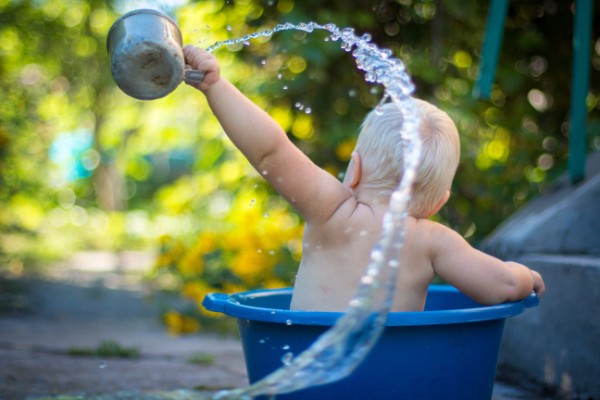With the summer finally upon us, most of us are pleased to welcome the warmer weather, but we also know how challenging it can be to keep your child cool in the heat. Here are some top tips on keeping babies and children cool in the summer months.

Prevent your child from overheating
Babies and children in their early years can struggle to regulate their body temperature, this is exacerbated even more so when we have warm days. We know how uncomfortable this can feel, the excessive sweating, breathing and thirst are just some of the side effects of being too warm. Therefore it is important on hot days to prevent your baby and child from overheating.
Here are some tips on how to do just that:
- Hydrate, hydrate, hydrate (cold water- give them great independence skills by letting the older children practice pouring their own water in open cups )
- Eat cold/frozen foods (popsicles, frozen fruit, smoothies, salads-have a fun cooking activity by making the frozen fruit or smoothies with your children)
- Stay in the shade (go into the woods- gaze up at the beautiful canopies of trees and see what birds you can find)
- Avoid peak heat hours (11:00 am – 2:00 pm)
- Dress accordingly (light, loose, airy clothing)
- Get wet! (Use this as an opportunity to introduce fun water play, and introduce mathematical language by pouring and tipping water jugs. Spray some cool water on their feet/hands.)
- Never put a blanket over your baby’s car seat/pushchair, this may provide shade but due to the fabric of the blanket it will in fact make the baby warmer
- Invest in a fan to clip onto your pram to direct a cool wind on your baby
Keep your baby hydrated
The NHS recommends that infants under six months old shouldn’t drink water so it may seem harder to keep them hydrated. If you are breastfeeding, you will probably find that your baby wants to feed more throughout the day/night to quench their thirst. We also suggest for slightly older babies to have their water bottle filled as much as possible, if it is there in front of them they will be more likely to drink from it. For older children, again use this as a great opportunity to teach great independence skills by letting them try to pour their own water into their cups.
Cool your “hot zones”
There are pressure points in your body that can quickly add to the heat your body is producing. When you’re super hot, try applying a little ice pack or a bottle filled with iced water to these specific spots and that will help your child cool down immediately. Use this opportunity to teach children vocabulary of their body parts.
- Temples
- Neck
- Ankles
- Behind the knees
- Wrists
- Bends of your elbow
Keep your baby’s or child’s room cool in summer
Think about how you feel on warm nights, often restless with the heat, your baby and child will feel the same. You need to ensure their room is kept cool so they are able to get a good night’s sleep – as well as you!
Here are some suggestions on how you can do this:
- Use a thermometer to measure the temperature in their room
- Invest in a fan or a portable air conditioning unit to reduce the temperature in their room
- Dress your baby appropriately for the weather, just a nappy or underwear may be all that’s required!
- Don’t worry about using a blanket
- Keep their blinds or curtains closed throughout the day to block out sunlight
The signs of heatstroke in children
Babies and toddlers have an increased risk of overheating as they are not as efficient at regulating their body temperature. It’s important to know the first signs of heatstroke or heat exhaustion and constantly be on the lookout for any symptoms if you’re going to spend time in the summer heat.
The symptoms of heat exhaustion can include stomach and leg cramps, thirst, being tired, or cool moist skin. Touch your children often to feel the texture and temperature of their skin. If you notice any of these things, act immediately to cool your child down to prevent heat stroke.
The symptoms of heatstroke in children include:
- a high temperature of 103F (39.4 C) degrees and above without sweating
- headache, which can cause irritability
- restlessness
- lethargy
- vomiting
- breathing that is shallow and quick
- unconsciousness
- dizziness or confusion
Remember that sweating, being red-faced, thirsty, and warm are normal reactions to heat. It is when your child shows any abnormal reactions (such as those listed above), that the situation becomes incredibly dangerous. Act immediately to get your child help.
Make sure you take all the precautions you can to keep your baby cool so that they can enjoy and make the most of the summer. Remember to use your thermometer at night to check on their room temperature, and don’t forget, even though creating shade for them with a muslin or blanket might seem like a good idea, it will actually make them warmer.
Get in touch
Here at All About children, we consciously make sure the children at our nursery are always as comfortable as possible. If you’d like to find out more information on keeping your baby cool in summer or how we do this, please contact us today.
